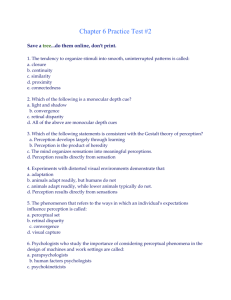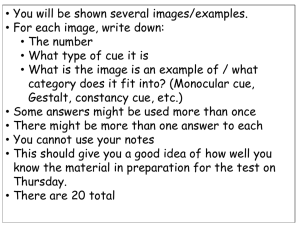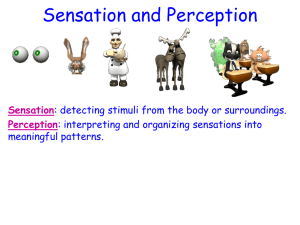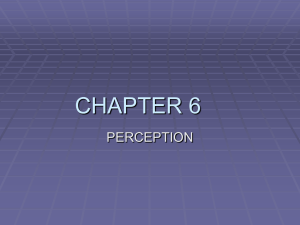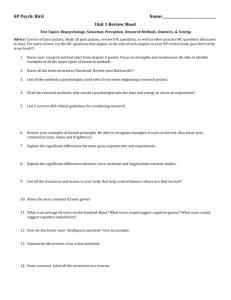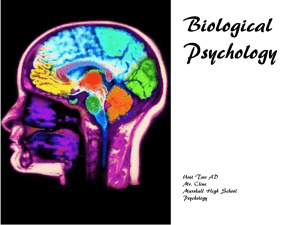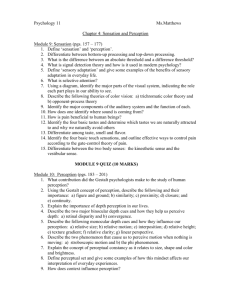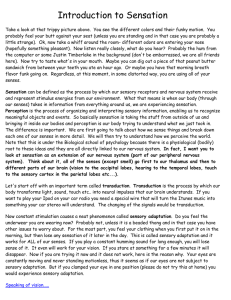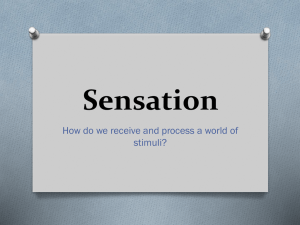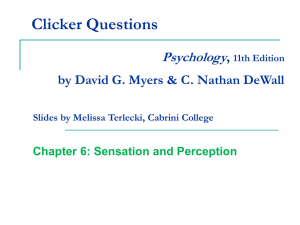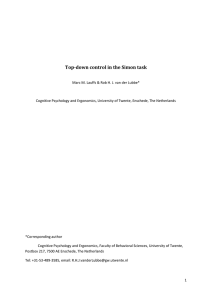Review Guide
advertisement
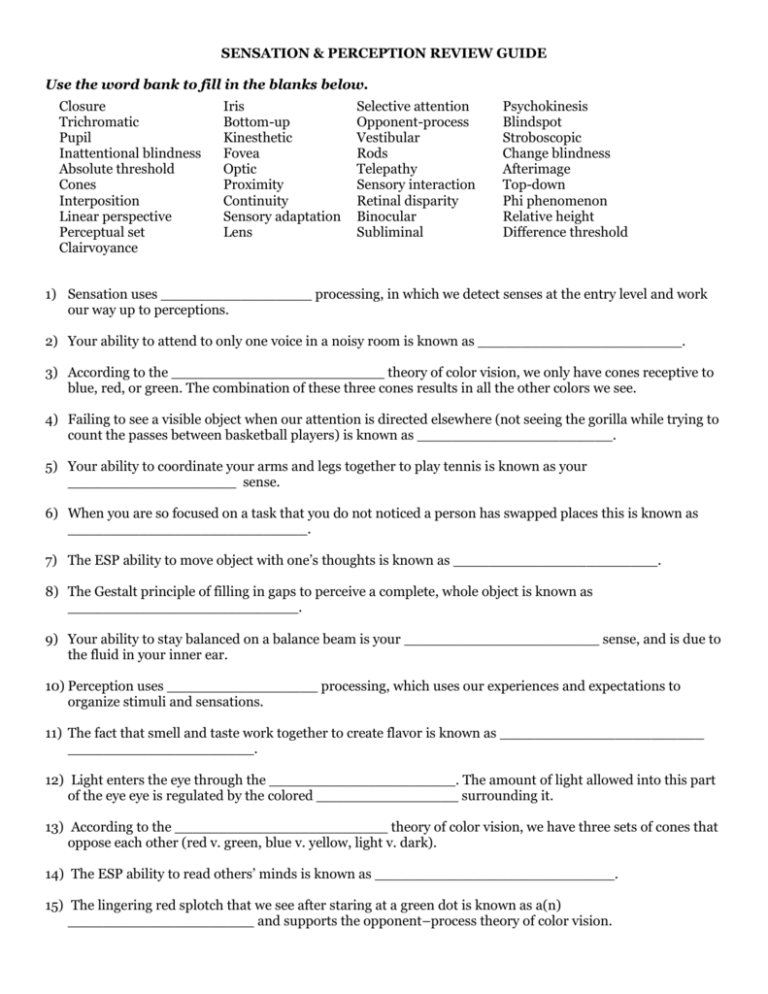
SENSATION & PERCEPTION REVIEW GUIDE Use the word bank to fill in the blanks below. Closure Trichromatic Pupil Inattentional blindness Absolute threshold Cones Interposition Linear perspective Perceptual set Clairvoyance Iris Bottom-up Kinesthetic Fovea Optic Proximity Continuity Sensory adaptation Lens Selective attention Opponent-process Vestibular Rods Telepathy Sensory interaction Retinal disparity Binocular Subliminal Psychokinesis Blindspot Stroboscopic Change blindness Afterimage Top-down Phi phenomenon Relative height Difference threshold 1) Sensation uses _________________ processing, in which we detect senses at the entry level and work our way up to perceptions. 2) Your ability to attend to only one voice in a noisy room is known as _______________________. 3) According to the ________________________ theory of color vision, we only have cones receptive to blue, red, or green. The combination of these three cones results in all the other colors we see. 4) Failing to see a visible object when our attention is directed elsewhere (not seeing the gorilla while trying to count the passes between basketball players) is known as ______________________. 5) Your ability to coordinate your arms and legs together to play tennis is known as your ___________________ sense. 6) When you are so focused on a task that you do not noticed a person has swapped places this is known as ___________________________. 7) The ESP ability to move object with one’s thoughts is known as _______________________. 8) The Gestalt principle of filling in gaps to perceive a complete, whole object is known as __________________________. 9) Your ability to stay balanced on a balance beam is your ______________________ sense, and is due to the fluid in your inner ear. 10) Perception uses _________________ processing, which uses our experiences and expectations to organize stimuli and sensations. 11) The fact that smell and taste work together to create flavor is known as _______________________ _____________________. 12) Light enters the eye through the _____________________. The amount of light allowed into this part of the eye eye is regulated by the colored ________________ surrounding it. 13) According to the ________________________ theory of color vision, we have three sets of cones that oppose each other (red v. green, blue v. yellow, light v. dark). 14) The ESP ability to read others’ minds is known as ___________________________. 15) The lingering red splotch that we see after staring at a green dot is known as a(n) _____________________ and supports the opponent–process theory of color vision. 16) The minimal amount of a stimulus we can consciously detect, such as the dimmest light we can see, is the ___________________ ___________________. 17) The clearest images we see are projected onto the ________________ of the retina at the back of our eyes. 18) The photoreceptors for vision are located on the _________________ at the back surface of our eyeballs; the ____________________ are sensitive to black/white while the ______________ are sensitive to color. 19) Our _____________ nerve transmits visual messages from the eye to the brain’s visual cortex. 20) The smallest change in stimulus, such as the smallest change in volume we can detect, is known as the ________________ ________________. 21) By changing its curvature and thickness, the _________________ focuses a nearby or far away object onto the retina. 22) Where the optic nerve hits the back of each eye is known as the __________ _________ because we have no receptors for vision there. 23) Being able to see into the future, and therefore know of events that have not yet happened, is known as the ESP quality of ___________________________. 24) When we become less sensitive to a stimulus over time, such as the feeling of our clothes on our skin after we have worn them all day, is known as __________________ __________________. 25) Information presented below our absolute threshold for sensations is considered ________________________ perception. 26) The tendency to organize stimuli into smooth, continuous patterns is known as the Gestalt principle of _____________________. 27) Perceiving depth because an object blocks in front of another object is known as the monocular cue of ___________________________. 28) When we group objects together because they are nearer to one another, we are using the Gestalt principle of _______________________. 29) ______________ _______________ means that our left and right eyes receive a slightly different perspective on an image but our brain combines them to create depth. 30) The illusion of movement that results when two adjacent stationary spots of light blink on and off in quick succession is called the ___________ ___________________________. 31) Parallel lines appear to converge in the distance due to the monocular depth cue of __________________ _____________________. 32) The brain interprets a rapid series of slightly varying stationary images as motion due to the _______________________ motion. 33) Any depth cue that requires two eyes is known as a ____________________ cue. 34) Objects lower in our visual field are perceived as closer than those higher in our visual field due to the monocular depth cue of ______________________ ________________. 35) A mental predisposition that influences perception is called a ________________ _______.


